Author: Grégoire Chéron
Deterioration of the weather window, return to standby for Gitana Team
That’s the way records are set! Having switched to code orange yesterday for a potential departure offshore of Ushant within 72 hours, namely over the course of the day on Wednesday 18 November, in the space of 24 hours the crew of the Maxi Edmond de Rothschild has seen its chance of setting sail on the round the world record under sail simply vanish. These comings and goings are very much a part of the game of strategy that colours these Jules Verne Trophy departures, especially in light of the fact that the current record held by the crew of Idec Sport is so high that there must be no doubt about the launchpad’.
Yesterday, the evening’s grib files were already hinting at a deterioration in the weather window being targeted by the Gitana Team. Unfortunately, this trend was confirmed over the course of the day leading to a return to standby for the men of the Maxi Edmond de Rothschild.
“Yesterday, we switched to code orange with a departure possibility that we reckoned to be between 70% and 80%. We were waiting for this window to develop in a bid to obtain a greater degree of certainty about the connection in the South Atlantic. However, yesterday evening, it was in the North Atlantic that the situation deteriorated with the appearance of a tropical depression sprawled across the route through to the trade wind. This new element is not favourable for a departure as it would likely prolong our trajectory towards the southern hemisphere considerably. At the same time, the models were also predicting a very long course along the coasts of Brazil and Uruguay to get around the high pressure associated with Saint Helena, which is not the way to secure a record,” explained Charles Caudrelier.
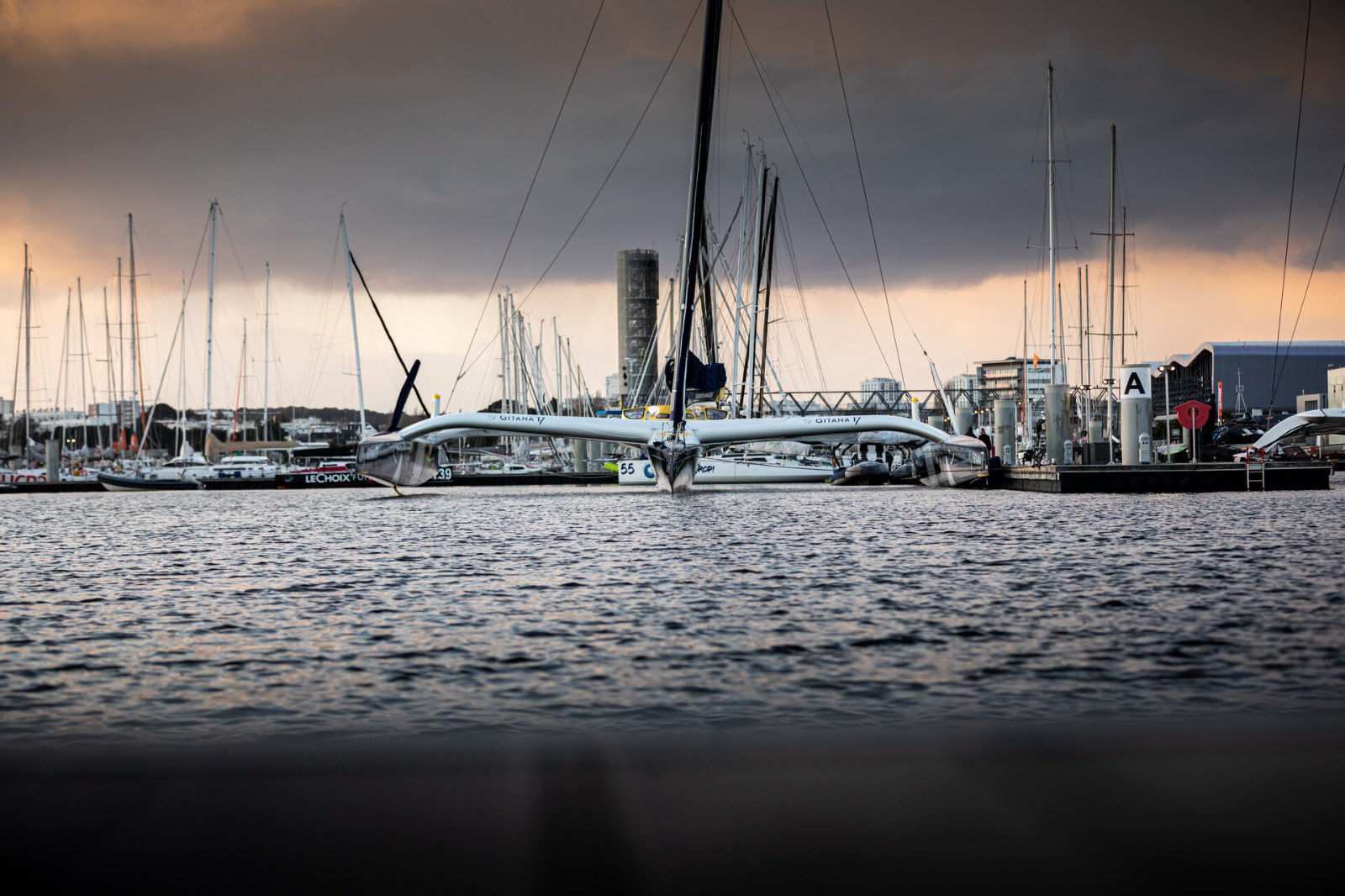
OVER 5 DAYS TO THE EQUATOR
“Therein lies the difficulty of these pre-start periods! The desire to set sail is inevitably much in evidence, but we’re at the start of our standby and we mustn’t rush into it. The record will be tough to hunt down and we need an ambitious departure window if we are to stand a good chance,” added Charles.
Meantime, Franck Cammas was keen to point out that: “The timing criteria we’re striving for are dictated by the performance we know that the Maxi Edmond de Rothschild is capable of, together with the analysis of the different record sequences posted by Idec in 2017. The passage to the equator and the time to Cape Agulhas are our primary criteria. Over 5 days to the equator is no longer a good window and that’s what the routing was offering us.”
The crew of the Maxi Edmond de Rothschild
Franck Cammas and Charles Caudrelier, skippers
Morgan Lagravière, Yann Riou, Erwan Israël and David Boileau.
Reminder of the standby codes
During the period of standby for the Maxi Edmond de Rothschild, which the five-arrow team has scheduled to run from 1 November to the first few days of February 2021, any changes in the situation and a possible departure date for the boat are announced via a colour coding system as detailed below:
– Black: no departure possible within 96hrs
– Red: observation of a possible departure between 72 and 96hrs
– Orange: observation of a possible departure between 48 and 72hrs
– Yellow: probable departure between 24 and 48hrs
– Green: departure within 24hrs
(FR) SPINDRIFT 2 ARRÊTE SA TENTATIVE SUR LE TROPHÉE JULES VERNE : LES EXPLICATIONS DE YANN GUICHARD
MAJOR RUDDER PROBLEM: SPINDRIFT 2 IS FORCED TO ABANDON
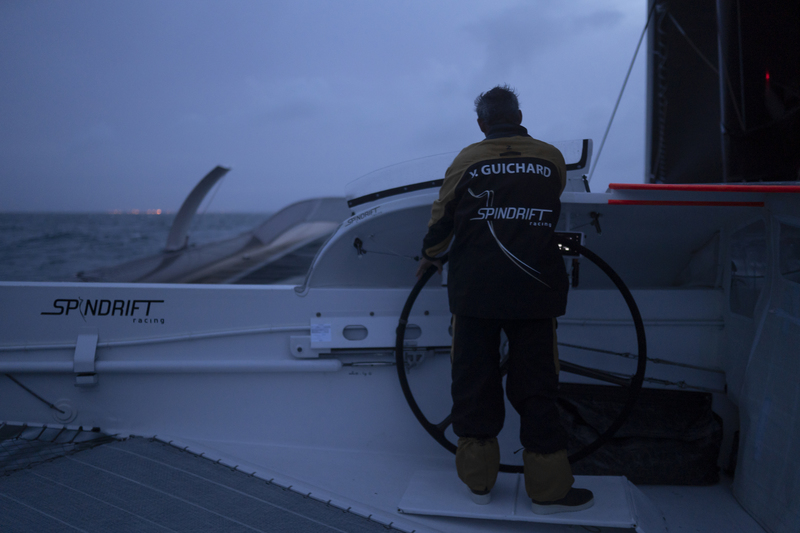
SPINDRIFT 2 LEAVES LA TRINITÉ-SUR-MER
Yann Guichard and his eleven crew left the dock in La Trinité-sur-Mer today (Tuesday) at 1130hCET to make their way to the start line of the Jules Verne Trophy. It is anticipated that the maxi trimaran will cross the line off the Créac’h Lighthouse (Ushant) at about 2100hCET this evening. With the current moderate easterly sea breeze, Spindrift should take between six to seven hours to reach the start line area.

© Chris Schmid / Spindrift racing
There were some emotional scenes when the twelve-strong Spindrift 2 crew said their goodbyes to relatives and friends on the pontoon at La Trinité-sur-Mer, before setting off for their forty-day record-breaking attempt around the world. As black and gold trimaran eased its way out of the harbour in bright sunshine and a steady easterly breeze, they hoisted their mainsail at the mouth of the river and setting their bows toward the start line at the Créac’h Lighthouse at Ushant, some six to seven hours away. It was a peaceful start and this same tempo looks set to accompany them, as the conditions in the Bay of Biscay look calm and flat for the first few hours of this third attempt on the record.
Five days and dust …
“There is a good weather window that shows us reaching the equator in a little over five days and the South Atlantic seems to be improving so, hopefully the first section of this record will be good. Spindrift 2 has two new rudders that will allow us to further improve on performance but nevertheless, the record will be difficult to beat! Whatever happens, it is an incredible voyage, and it’s still a human, technical and sports adventure. The crew is really motivated and my core team that has been part of this journey before. So we will leave the Bay of Biscay in relatively quiet conditions before accelerating significantly after Cape Finisterre… ” said Yann Guichard before leaving the dock.
Spindrift 2 is due to start the 21,600 mile course on Tuesday, December 3 at 2100h CET. The course is marked by three legendary capes: Good Hope (south of the African continent), Leeuwin (south-west of Australia), Horn (south of the American continent). This is the team’s third attempt at targeting the 40d 23h 30 ’30’ record around the world.
“You have to be persistent in the Jules Verne Trophy! First you need a good, well-prepared boat, good chemistry amongst the crew and of course, favourable weather conditions. The conditions look to be relatively easy at first, which will give us a nice descent to the Equator. We anticipate that we should be able to reach the Cape of Good Hope in twelve days, which is a very good time compared to the reference time.” Says Erwan Israel (navigator).
Cape of Good Hope: a Focus
“I am very happy with this rather peaceful and calm departure from La Trinité-sur- Mer: it is good way to start a world tour for the first time, so it will be a really big adventure! I do not know the Southern Ocean or the Southern Hemisphere… You experience four seasons during this Jules Verne Trophy: we leave in the autumn, we enter the South Atlantic in the spring, we complete the Southern Ocean in early summer and finish in Brittany in the middle of winter… ” notes the novice Grégory Gendron.
The round-the-world record, which in a quarter of a century has been reduced from 79 days (Commodore Explorer in 1993) to a little over 40 days (IDEC Sport in 2017), usually requires two or three attempts before it is broken. The record has been successfully won by Peter Blake and Robin Knox-Johnston (Enza New Zealand in 1994), Olivier de Kersauson (Sport Elec in 1997), Bruno Peyron (Orange in 2002), Steve Fossett (Cheyenne in 2004), Bruno Peyron (Orange 2 in 2005), Franck Cammas (Groupama 3 in 2010), Loïck Peyron (Banque Populaire V in 2012) …
“I’m not the only one onboard to already have the record, there is also Xavier Revil! Six out of twelve of us have already completed the round the world in a multihull but a coordinated crew, that works well together and knows the boat that, we have optimised over the years, is a key ingredient. Spindrift 2 is now lighter, so more able to get airborne with the added advantage of being able to adjust the thrust with rudders, so it more efficient, and more sensitive. We are trying for a third time, but the Jules Verne Trophy becomes a bit of a habit because as a crew you get hooked after the first attempt! “Says Thierry Chabagny (helmsman).
The crew of Spindrift 2 has changed very little with only Corentin Horeau and Grégory Gendron joining the core team, which made a previous attempt at the beginning of this year. Under the leadership of Yann Guichard, the black and gold trimaran is, once again, ready to face Neptune’s moods as they attempt to beat forty days on this world tour.
“When we arrive back in Brest, I will have completed my first world tour, my first passing of Cape Leeuwin and my first Cape Horn. Last time I only reached the Indian Ocean before we broke our rudder… The conditions for the start are calm, which feels bittersweet as we leave our ‘home’ for the start. The key now is to get a good time to the Equator and on to the Cape of Good Hope. ” Concludes Erwan Le Roux (boat-captain).
JULES VERNE TROPHY: TUESDAY NIGHT DEPARTURE FOR SPINDRIFT 2
Spindrift 2 is preparing for a new attempt on the Jules Verne Trophy, the round the world record that starts and finishes in Ushant, leaving the three capes (Good Hope, Leeuwin, Horn) to port. The reference time is the current record set by Francis Joyon and his crew in 2017, of 40 days, 23 hours, 30 minutes and 30 seconds. With their optimised maxi trimaran and a crew of eleven, skipper Yann Guichard is aiming to start this new attempt on the night of Tuesday 3 to Wednesday, 4 December.
© Maxime Horlaville / Polaryse / Spindrift racing
Yann Guichard and crew will cross the line during the night of December 4th, in front of the Créac’h lighthouse (Ushant) to begin the 21,600 mile route (following the Great Circle, which is the direct route chosen by the WSSRC, the international organisation that ratifies sailing records), with the aim of beating the record of 40 days, 23 hours, 30 minutes and 30 seconds. Based on its performance on a previous attempt, the black and gold trimaran could have the record on target, especially given recent technical improvements to the trimaran, including setting rudder fins to better sustain the Spindrift 2 at high speed.
A third attempt
Yann Guichard and his crew have tried to beat the record on two previous occasions: in 2015 (47d 10h 59 ‘) with Dona Bertarelli, who became the fastest woman around the world, and in 2018 (where the team was forced to abandon their attempt following rudder failure close to the Kergulen Islands). However now, once again, the North Atlantic has a favourable weather window that could allow a passage to the equator in about five days.
“We will start from La Trinité on Tuesday morning to cross the starting line of the Jules Verne Trophy at Ushant between 18:00 on Tuesday and 6:00 on Wednesday: once we see how the weather is evolving, we will be able to refine this window. The conditions are quite good, with a time at the equator of around five days. We should be able to leave the eastern sector in the Bay of Biscay with a moderate breeze and then we will benefit from trade winds that ill strengthen to the north of Portugal. We will have make some gybes to get to Madeira before performing our swoop down into the doldrums.” Says Yann Guichard.
But if the descent to the Equator looks favourable, the round the world record can still be lost at the Cape of Good Hope. Spindrift 2 already holds the fastest time between Ushant and the Equator made during the second attempt in early 2019 (4d 20h 07 ‘), but it is the ability to improve the reference time to the Cape of Good Hope and arrive at the Indian Ocean with time in hand that is critical. Francis Joyon had an extremely fast crossing of this second ocean in 2017 (5d 21h 07 ‘). Spindrift 2 must therefore keep to an average speed of about 23 knots to South Africa, to ensure that there is enough margin on the reference time to start the next section.
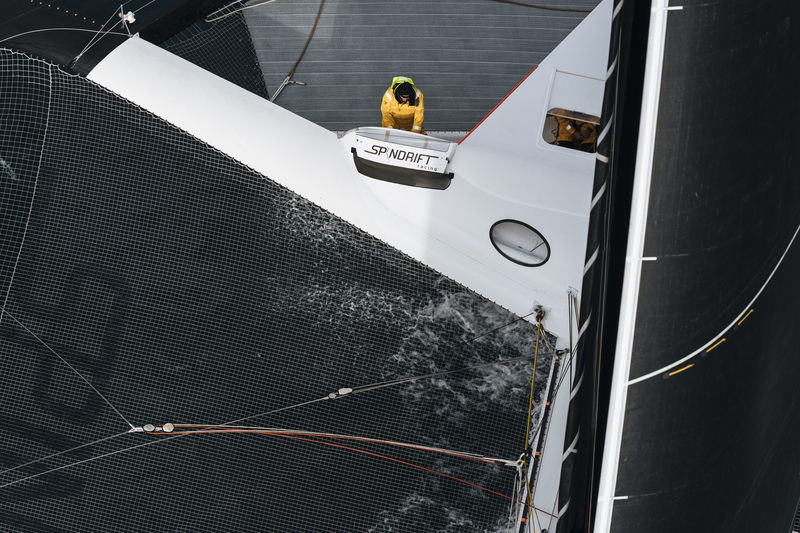
© Chris Schmid / Spindrift racing
North-South sequence
“The doldrums seem more favourable to the East as we have seen during the recent Transat Jacques Vabre and Brest Atlantiques. To get into the Southern Hemisphere in good shape: we hope to pass the Cape of Good Hope in less than thirteen days, which would allow us to be ahead of Francis Joyon’s time. While it is still a bit far out, we can already see that the South Atlantic is not closed and we could hook into a depression off Brazil to arrive on South Africa quite quickly.” Says the skipper of the black and gold trimaran.
Spindrift 2 is ready for this new attempt with a total crew of twelve, including two newcomers: Grégory Gendron and Corentin Horeau., who know the boat well and are already well integrated into the team. “We will leave with conditions more pleasant than usual, and the day after the start, it will not be as cold … It is a fairly standard route but we hope it will be rather fast – to the equator at least!” Concludes Yann Guichard.
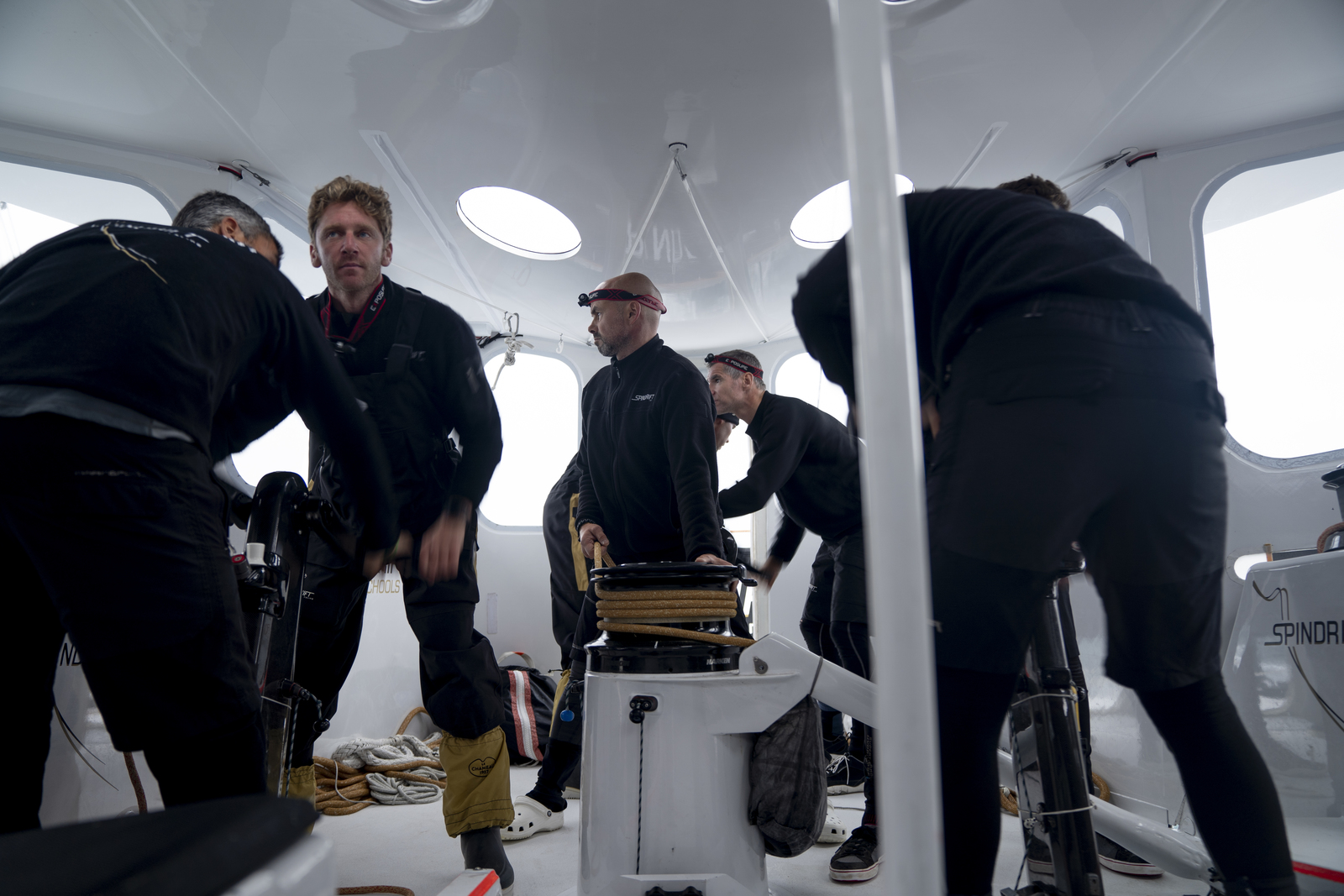
© Maxime Horlaville / Polaryse / Spindrift racing
SPINDRIFT 2 BACK ON STANDBY
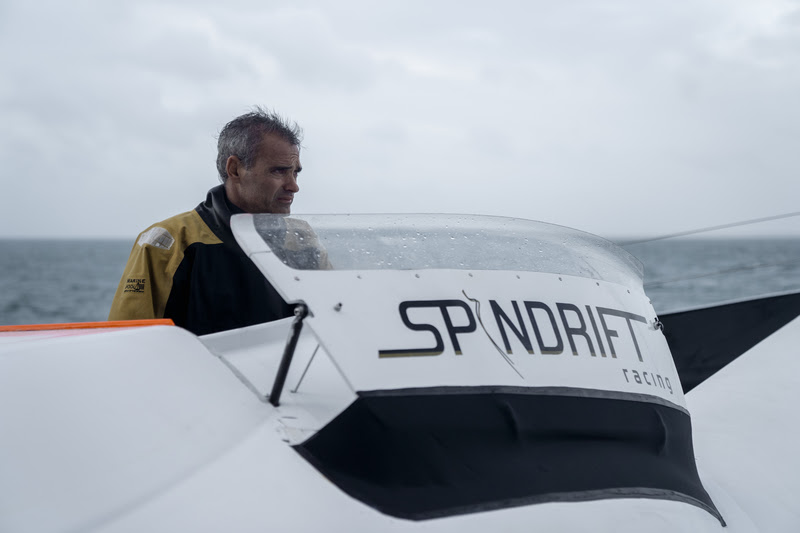
© Maxime Horlaville / Polaryse / Spindrift racing
Yann Guichard and his crew will be back on standby early next week, awaiting a favourable weather window to set sail on their third Jules Verne Trophy record attempt.
Since October 29th, the team had been focused exclusively on repairing Spindrift 2’s rudder ever since a problem was detected while training offshore. “We have experienced another race against the clock, here at Spindrift racing. For the past 3 weeks, we have been focused exclusively on finding solutions to fix the multihull’s rudder. I would like to thank the entire technical team for their hard work. We’re now ready to set sail, and our eyes are turned on the weather forecasts. Our standby is extended until mid December ”explained Yann Guichard.
The objective? Beat the existing round the world non-stop sailing record of 40-days, 23-hours, 30-minutes set by Francis Joyon in 2017. If the weather conditions along the route are favourable, it is an achievable goal. “We would like to be a day ahead of the record by the time we reach the Indian Ocean. Francis Joyon crossed this stretch of ocean in a record time and it will be difficult to beat,” says Yann Guichard.
SPINDRIFT 2 – JULES VERNE TROPHY SQUAD:
Yann Guichard – skipper
Erwan Israël – navigator
Jacques Guichard – watch leader / helm
Jackson Bouttell – helm / bow
Thierry Chabagny – helm
Grégory Gendron – helm
Xavier Revil – watch leader / helm
Corentin Horeau – helm / bow
François Morvan – helm
Duncan Späth – helm
Erwan Le Roux – watch leader / helm
Benjamin Schwartz – helm / bow
Jean-Yves Bernot – router
THE JULES VERNE TROPHY:
Start and finish: an imaginary line between Créac’h lighthouse (Isle of Ushant) and Lizard Point (England)
Course: non-stop around-the-world tour travelling without assistance via three capes (Good Hope, Leeuwin and Horn)
Minimum distance: 21,600 nautical miles (40,000 kilometres)
Ratification: World Sailing Speed Record Council, www.sailspeedrecords.com
Time to beat: 40 days, 23 hours, 30 minutes and 30 seconds
Average speed: 22,84 knots
Date of current record: January 2017

